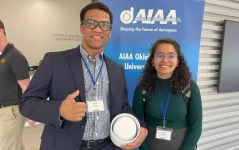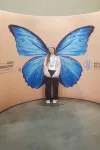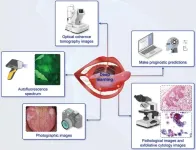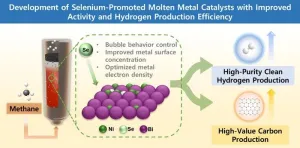(Press-News.org) Aerospace engineering senior Philip Wilson attended an American Institute of Aeronautics and Astronautics (AIAA) conference. Rohit Raut, a senior physics major, presented his work at a nuclear research symposium, and senior biology major Jaden Rankin had the opportunity to feature her research at an entomology conference.
These and other University of Texas at Arlington students were able to showcase their original research at major symposiums thanks to UTA’s expansion of its popular undergraduate research program that provides funding for select students to present at academic conferences.
“At the conference, I presented my work on rotating detonating engine nozzles to students from other universities, professors and other AIAA members,” said Wilson, who along with his partner, Khushi Piparava, presented their work and won second place among student presenters. “I got to see the research and work done by my peers at other universities, and it solidified my plans to stay on at UTA and pursue my Ph.D. in aerospace engineering.”
The initial expansion of this program supported eight students, each receiving up to $1,000 based on the costs of attending a symposium.
“We’re allowing a select group of students to showcase their original research at international conferences, which allows students to network with future collaborators, talk to possible employers and experience firsthand what it’s like to be an established researcher,” said Kayunta Johnson-Winters, director of undergraduate research at UTA and an associate professor of chemistry and biochemistry. “The response from the students and their faculty advisors has been so encouraging.”
The program enabled Raut, an aspiring physicist, to attend a meeting at CERN, the European Organization of Nuclear Research.
“As a physicist and a researcher, it’s always exciting to be at CERN,” Raut said. “You never know if the person standing next to you in the lunch line is the physicist who inspired you to pursue physics.”
Raut will graduate in the spring and is applying to doctoral programs to study high-energy physics, particularly in neutrino and dark sector research, which explores the fundamental particles and forces that shape the universe.
Rankin said her experience in the program has strengthened her commitment to pursuing graduate studies in biology.
“Attending Entomology 2024 last November allowed me to learn more about the field of insect research,” she said. “It was my first major research symposium, and it was so incredibly exciting to meet people at all levels of education.
“I plan to pursue a Ph.D. and possibly work in a national park after I finish my studies.”
Ken Perry presented research on the connection between high-fat meals and cardiovascular health—conducted with his faculty mentor, R. Matthew Brothers—at the American Physiological Society meeting. He received two awards for his presentation.
“The first award was given to about 100 people, but the second was more of a competition meant to honor the top 10 undergraduates at the entire conference, which had over 20,000 people,” Perry said. “It was really a huge honor for me.”
Ben Gervasi, a senior art history major, attended the Midwest Art History Society Conference, calling it an “amazing opportunity to network with experts in the field.”
After earning his degree this spring, Gervasi plans to attend graduate school to further his study of late-19th-century French art. Eventually, he hopes to teach at the university level.
“Research is not confined to the papers you write,” Gervasi said. “The events you attend and the places you explore naturally inspire your research and keep it fresh.”
Program participants:
Lucine Devejian, Fort Worth (Nolan Catholic High School)
Attended American Society for Biochemistry and Molecular Biology, San Antonio
Ben Gervasi, Arlington, (Martin High School)
Attended Midwest Art History Society Conference, Chicago
Ken Perry, Arlington (Arlington High School)
Attended American Physiological Society Summit, Long Beach, California
Ravi Ramkissoon, Mansfield (Timberview High School)
Attended American Society for Biochemistry and Molecular Biology, San Antonio
Attended American Chemical Society, Youth Challenge, Singapore, February 2025
Jaden Rankin, Terrell (North Forney High School)
Attended Entomology 2024, Phoenix
Rohit Raut, Jhapa, Nepal (Dhulabari Secondary School)
Attended DUNE Collaboration Meeting and DUNE LArTPC Analysis Workshop, Geneva, Switzerland
Philip Wilson, Mansfield (Mansfield High School)
Attended AIAA Region IV Student Conference of 2024, Stillwater, Oklahoma
Carson Wright, Waxahachie (Waxahachie Global High School)
Attending Symposium for the Communication of Complex Information in March 2025, Saint Paul, Minnesota
Learn more about UTA’s Undergraduate Research Opportunities on its website or email the office.
About The University of Texas at Arlington (UTA)
Located in the heart of the Dallas-Fort Worth Metroplex, The University of Texas at Arlington is a comprehensive teaching, research, and public service institution dedicated to the advancement of knowledge through scholarship and creative work. With an enrollment of approximately 41,000 students, UT Arlington is the second-largest institution in the UT System. UTA’s combination of outstanding academics and innovative research contributes to its designation as a Carnegie R-1 “Very High Research Activity” institution, a significant milestone of excellence. The University is designated as a Hispanic Serving-Institution and an Asian American Native American Pacific Islander-Serving Institution by the U.S. Department of Education and has earned the Seal of Excelencia for its commitment to accelerating Latino student success. The University ranks in the top five nationally for veterans and their families (Military Times, 2024), is No. 4 in Texas for advancing social mobility (U.S. News & World Report, 2025), and is No. 6 in the United States for its undergraduate ethnic diversity (U.S. News & World Report, 2025). UT Arlington’s approximately 270,000 alumni occupy leadership positions at many of the 21 Fortune 500 companies headquartered in North Texas and contribute to the University’s $28.8 billion annual economic impact on Texas.
END
Program’s expansion boosts student research opportunities
UTA undergraduate research program helps students present their work at academic conferences
2025-02-26
ELSE PRESS RELEASES FROM THIS DATE:
Deep learning in the diagnosis and prognosis of oral potentially malignant disorders
2025-02-26
Oral cancer remains a serious global health concern due to its high morbidity and mortality rates, primarily caused by late-stage diagnosis. The presence of oral potentially malignant disorders (OPMDs) provides an opportunity for early intervention, as these lesions precede the development of oral squamous cell carcinoma. However, the accurate detection and classification of OPMDs remain challenging due to their diverse clinical presentations. Conventional diagnostic methods, including visual examination and histopathological ...
Some fuel lodges in the inner walls of fusion vessels. Researchers now have a better idea of how much.
2025-02-26
To develop a practical fusion power system, scientists need to fully understand how the plasma fuel interacts with its surroundings. The plasma is superheated, which means some of the atoms involved can strike the wall of the fusion vessel and become embedded. To keep the system working efficiently, it’s important to know how much fuel might be trapped.
“The less fuel is trapped in the wall, the less radioactive material builds up,” said Shota Abe, a staff research physicist at the U.S. Department of Energy’s (DOE) Princeton Plasma Physics Laboratory (PPPL).
Abe is the lead researcher on a new study published in Nuclear ...
Bismuth-based catalysts: Promising candidates for electrochemical CO2 reduction to formate
2025-02-26
The electrochemical reduction of CO2 has been recognized as a promising strategy to convert ambient atmospheric CO2 into valuable products. Bismuth-based catalysts have garnered the widespread attention of researchers due to their cost-effectiveness, low toxicity, and high natural abundance. Significant progress has been made toward enhancing the reactivity of catalyst structures through innovative synthesis techniques and engineering. Advances include the use of flow cells and membrane electrode assembly (MEA) cells to attain high cathodic current densities of over 200 mA cm-2 with superior ...
Novel molten metal catalysts for CO2-free hydrogen production
2025-02-26
Researchers in South Korea have developed an advanced liquid metal catalyst incorporating selenium (Se) to enhance the efficiency of turquoise hydrogen production.
Turquoise hydrogen is generated via methane (CH₄) pyrolysis, producing hydrogen while yielding solid carbon as a byproduct, without emitting carbon dioxide (CO₂).
A research team led by Dr. Seung Ju Han at the Korea Research Institute of Chemical Technology (KRICT) has introduced selenium-doped molten metal catalysts (NiBi, CuBi) to significantly enhance methane pyrolysis efficiency. The technology demonstrates ...
Beyond the burn: Harvesting dead wood to reduce wildfires and store carbon
2025-02-26
A century of fire suppression, combined with global warming and drought, has led to increasingly destructive wildfires in the Western United States. Forest managers use tools like prescribed burns, thinning, mastication, and piling and burning to reduce fuel – live and dead trees, needles and leaves, and downed branches – that can feed intense wildfires. These methods aim to lower fuel levels, reduce crown density, and protect fire-resistant trees, fostering healthier, more resilient forests.
However, prescribed burning efforts haven’t kept up with the rapid buildup of surface fuel, creating a “fire deficit” – the gap between the amount of fuel that has ...
Researchers at Case Western Reserve, University Hospitals to begin clinical testing with new, less-invasive technology to screen for esophageal precancer
2025-02-26
CLEVELAND—Researchers at Case Western Reserve University (CWRU) and University Hospitals (UH) will use state-of-the-art medical technologies they invented—and licensed to Lucid Diagnostics Inc.—to detect esophageal precancer, specifically Barrett’s Esophagus (BE).
BE is a change in the cellular structure of the esophageal lining typically caused by gastroesophageal reflux disease (GERD), also known as heartburn. The goal is to reduce the incidence of esophageal cancer (EAC).
EAC is a rare type of cancer with a high-morality rate—the cause of 2.6% of all cancer ...
JMC|With generative AI assistance, Insilico Medicine announces novel CDK12/13 dual inhibitors for tumor treatment
2025-02-26
Insilico Medicine ("Insilico"), a clinical stage generative artificial intelligence (AI)-driven biotechnology company, today announced the publication of a novel series of orally available covalent CDK12/13 dual inhibitors, as a potential option against refractory and treatment-resistant cancers. Published in the Journal of Medicinal Chemistry (IF=7.2), the study showcases the discovery of compound 12b, a potent, selective, and safe therapy targeting CDK12/13, empowered by Insilico’s proprietary generative AI platforms including PandaOmics and ...
Novel photochromic glass can store rewritable 3D patterns
2025-02-26
For decades researchers have been exploring how to store data in glass because of its potential to hold information for a long time — eons — without applying power. A special type of glass that changes color in different wavelengths of light, called photochromic glass, holds promise for stable, reusable data storage. Now, researchers have developed a doped photochromic glass that has the potential to store rewritable data indefinitely, according to research published in ACS Energy Letters.
Certain types of ...
Sea sponge inspires super strong compressible material
2025-02-26
Inspired by the humble deep-sea sponge, RMIT University engineers have developed a new material with remarkable compressive strength and stiffness that could improve architectural and product designs.
The double lattice design was inspired by the intricate skeleton of a deep-sea sponge known as Venus' flower basket, which lives in the Pacific Ocean.
Lead author of the latest RMIT study into the structure, Dr Jiaming Ma, said extensive testing and optimisation revealed the pattern's impressive combination of stiffness and strength, mixed with an ability to contract when compressed.
It’s this last aspect – known as auxetic behaviour – ...
AI generates playful, human-like games
2025-02-26
While we are remarkably capable of generating our own goals, beginning with child’s play and continuing into adulthood, we don’t yet have computer models for understanding this human ability.
However, a team of New York University scientists has now created a computer model that can represent and generate human-like goals by learning from how people create games. The work, reported in the journal Nature Machine Intelligence, could lead to AI systems that better understand human intentions and more faithfully model ...
LAST 30 PRESS RELEASES:
Kids’ behavioral health is a growing share of family health costs
Day & night: Cancer disrupts the brain’s natural rhythm
COVID-19 vaccination significantly reduces risk to pregnant women and baby
The role of vaccination in maternal and perinatal outcomes associated with COVID-19 in pregnancy
Mayo Clinic smartwatch system helps parents shorten and defuse children's severe tantrums early
Behavioral health spending spikes to 40% of all children’s health expenditures, nearly doubling in a decade
Digital cognitive behavioral treatment for generalized anxiety disorder
Expenditures for pediatric behavioral health care over time and estimated family financial burden
Air conditioning in nursing homes and mortality during extreme heat
The Alps to lose a record number of glaciers in the next decade
What makes a good proton conductor?
New science reporting guide published for journalists in Bulgaria
New international study reveals major survival gaps among children with cancer
New science reporting guide published for journalists in Turkey
Scientists develop a smarter mRNA therapy that knows which cells to target
Neuroanatomy-informed brain–machine hybrid intelligence for robust acoustic target detection
Eight SwRI hydrogen projects funded by ENERGYWERX
The Lundquist Institute and its start-up company Vitalex Biosciences Announces Strategic Advancement of Second-Generation fungal Vaccine VXV-01 through Phase 1 Trials under $40 Million Competitive Con
Fine particles in pollution are associated with early signs of autoimmune disease
Review article | Towards a Global Ground-Based Earth Observatory (GGBEO): Leveraging existing systems and networks
Penn and UMich create world’s smallest programmable, autonomous robots
Cleveland researchers launch first major study to address ‘hidden performance killer’ in athletes
To connect across politics, try saying what you oppose
Modulating key interaction prevents virus from entering cells
Project explores barriers to NHS career progression facing international medical graduates
Jeonbuk National University researchers explore the impact of different seasonings on the flavor perception of Doenjang soup
Two Keck Medicine of USC Hospitals named Leapfrog Top Teaching Hospitals
World-first discovery uncovers how glioblastoma tumours dodge chemotherapy, potentially opening the door to new treatments
A fatal mix-up: How certain gut bacteria drive multiple sclerosis
New AI tool identifies not just genetic mutations, but the diseases they may cause
[Press-News.org] Program’s expansion boosts student research opportunitiesUTA undergraduate research program helps students present their work at academic conferences










